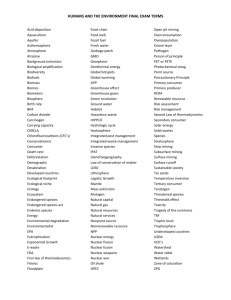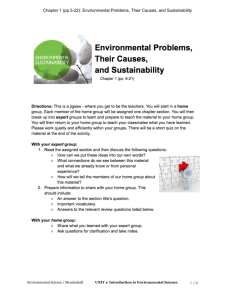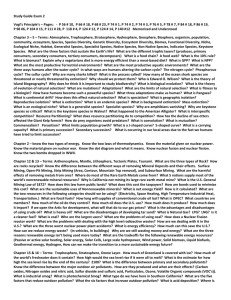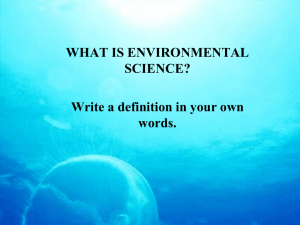APDP fall review
advertisement
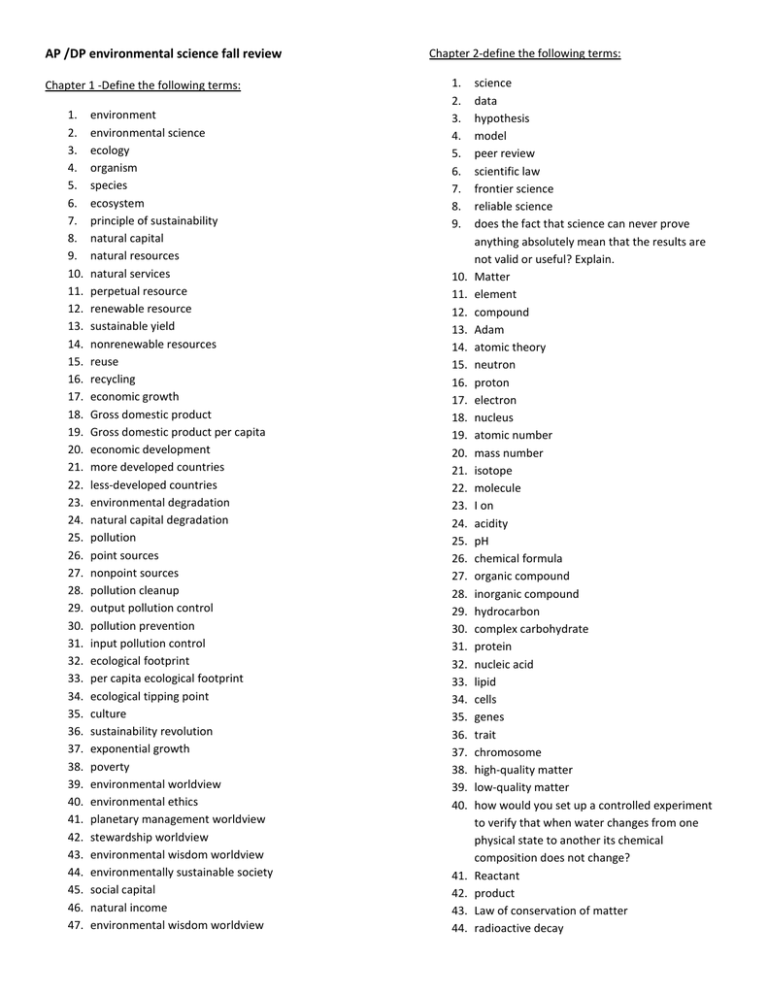
AP /DP environmental science fall review Chapter 1 -Define the following terms: 1. 2. 3. 4. 5. 6. 7. 8. 9. 10. 11. 12. 13. 14. 15. 16. 17. 18. 19. 20. 21. 22. 23. 24. 25. 26. 27. 28. 29. 30. 31. 32. 33. 34. 35. 36. 37. 38. 39. 40. 41. 42. 43. 44. 45. 46. 47. environment environmental science ecology organism species ecosystem principle of sustainability natural capital natural resources natural services perpetual resource renewable resource sustainable yield nonrenewable resources reuse recycling economic growth Gross domestic product Gross domestic product per capita economic development more developed countries less-developed countries environmental degradation natural capital degradation pollution point sources nonpoint sources pollution cleanup output pollution control pollution prevention input pollution control ecological footprint per capita ecological footprint ecological tipping point culture sustainability revolution exponential growth poverty environmental worldview environmental ethics planetary management worldview stewardship worldview environmental wisdom worldview environmentally sustainable society social capital natural income environmental wisdom worldview Chapter 2-define the following terms: 1. 2. 3. 4. 5. 6. 7. 8. 9. 10. 11. 12. 13. 14. 15. 16. 17. 18. 19. 20. 21. 22. 23. 24. 25. 26. 27. 28. 29. 30. 31. 32. 33. 34. 35. 36. 37. 38. 39. 40. 41. 42. 43. 44. science data hypothesis model peer review scientific law frontier science reliable science does the fact that science can never prove anything absolutely mean that the results are not valid or useful? Explain. Matter element compound Adam atomic theory neutron proton electron nucleus atomic number mass number isotope molecule I on acidity pH chemical formula organic compound inorganic compound hydrocarbon complex carbohydrate protein nucleic acid lipid cells genes trait chromosome high-quality matter low-quality matter how would you set up a controlled experiment to verify that when water changes from one physical state to another its chemical composition does not change? Reactant product Law of conservation of matter radioactive decay 45. 46. 47. 48. 49. 50. 51. 52. 53. 54. 55. 56. 57. 58. 59. 60. 61. 62. 63. 64. 65. 66. 67. nuclear fission nuclear fusion energy kinetic energy heat electromagnetic radiation energy quality high quality energy low-quality energy first law of thermodynamics Law of conservation of energy second law of thermodynamics system input flow or throughput feedback output feedback loop positive feedback loop negative feedback loop tipping point time delay synergistic interaction Chapter 3-define the following terms: 1. 2. 3. 4. 5. 6. 7. 8. 9. 10. 11. 12. 13. 14. 15. 16. 17. 18. 19. 20. 21. 22. 23. 24. 25. atmosphere troposphere greenhouse gases stratosphere hydrosphere geosphere bias here natural greenhouse effect ecology organism population community ecosystem biosphere trophic level producer autotrophic photosynthesis chemo synthesis what is the formula for photosynthesis? Consumer heterotrophs primary consumer ergo for carnivore 26. 27. 28. 29. 30. 31. 32. 33. 34. 35. 36. 37. 38. 39. 40. 41. 42. 43. 44. 45. 46. 47. secondary consumer tertiary consumer omnivore decomposer detritus feeder aerobic respiration Anaerobic respiration how is fermentation different from regular cellular respiration? Feed chain X line food web biomass X line permit of energy flow how is energy flow in an ecosystem related to the second law of thermodynamics? Gross primary productivity net primary productivity biogeochemical cycle nutrient cycle water cycle Carbon cycle nitrogen cycle phosphorus cycle sulfur cycle how are each of the above biogeochemical cycles related to balance within an ecosystem? How can Google Earth be used help scientists study changes in the environment? Chapter 4-define the following terms: 1. 2. 3. 4. 5. 6. 7. 8. 9. 10. 11. 12. 13. 14. biological diversity species biomes species diversity ecological niche generalist species specialist species k species r species native species non-native species indicator species East End species foundation species Chapter 5-define the following terms: 1. 2. 3. 4. 5. 6. interspecific competition parasitism mutualism commensal of them partitioning of resources competitive exclusion 7. 8. 9. 10. 11. 12. 13. 14. 15. 16. 17. 18. 19. 20. 21. 22. 23. 24. 25. predator predator prey relationships describe a trait possessed by the southern sea otter that helps it to catch its prey and a trait that helps it to avoid being preyed upon. Co-evolution demographics age structure range of tolerance limiting factors principle of limiting factor is X line environmental resistance carrying capacity is it possible for a population overshoot its carrying capacity? If so explain the result. Population crash population density how are human populations controlled by their by their environment? How are human populations controlled by society? Primary ecological succession secondary ecological succession inertia resilience Chapter 6-define the following terms: 1. 2. 3. 4. 5. 6. 7. 8. 9. 10. 11. 12. 13. 14. 15. 16. cultural carrying capacity crude birth rate crude death rate population change total fertility rate replacement level fertility rate according to the chart on page 132 in your book which two factors do you think were most important in changing population in the United States between 1900 and 2000? Explain. Life expectancy infant mortality rate age structure explain the shape of the following population pyramids: expanding rapidly, expanding slowly, stable and declining how does the population pyramid of a more developed country compared to that of a lessdeveloped country? Baby-boom how has AIDS impacted human population? What are some ways to promote economic development? Demographic transition 17. Why is it important to empower women in order to slow population growth? 18. Family planning 19. Demographic momentum Chapter 7-define the following terms: 1. 2. 3. 4. 5. 6. 7. 8. 9. 10. 11. weather climate Latitude longitude biome Desert permafrost grassland deciduous forest tropical rain forest boreal/coniferous forest Chapter 8-define the following terms: 1. 2. 3. 4. 5. 6. 7. 8. 9. 10. 11. 12. 13. 14. 15. 16. 17. 18. 19. 20. 21. 22. 23. 24. 25. 26. aquatic life zone saltwater freshwater plankton nekton benthos abyssal zone limnetic zone littoral zone profundal zone euphotic zone bathyal zone coastal zone wetlands intertidal zone crustacean estuary Blake eutrophic lake oligotrophic lake surface water runoff watershed drainage basin marsh coral reef Chapter 14-define the following terms: 1. 2. 3. geology core mantle 4. 5. 6. 7. 8. 9. 10. 11. 12. 13. 14. 15. 16. 17. 18. 19. 20. 21. 22. 23. 24. 25. 26. 27. 28. 29. seismic waves drift asthenosphere Christ tectonic plates Ring of fire earthquake Volcano vent tsunami rock cycle sedimentary rock igneous rock X line metamorphic rock high-grade ore low-grade ore mining surface mining overburden open pit mining strip mining contour strip mining mountaintop removal subsurface mining reclamation depletion time scarce minerals Chapter 2 teen-define the following terms: 1. 2. 3. 4. 5. 6. 7. 8. 9. 10. 11. 12. 13. 14. 15. 16. 17. 18. negative net energy yield petroleum peak production petrochemical proven oil reserves unproven reserves OPEC ANWR a much of the world's proven crude oil reserves are housed in the United States? What countries are major importers of crude oil to the United States? Can the United States ever catch up in the oil race? Tar sand shale oil tracking liquefied petroleum gas liquefied natural gas methane hydrate coal 19. what are the four types of coal and which ones are used in manufacturing? Why? 20. Sulfur dioxide 21. coal ash 22. nuclear fission reactor 23. explain how I nuclear fission reactor works? 24. Chernobyl 25. what are some advantages and disadvantages of running nuclear reactors? 26. How to country Joe and radioactive waste reduced from a nuclear power plant? 27. New generation nuclear reactor Chapter 16-define the following terms: 1. 2. 3. 4. 5. 6. 7. 8. 9. 10. 11. 12. 13. 14. 15. 16. 17. 18. 19. energy efficiency cogeneration combined heat and power biofuel wind energy solar energy passive solar heating system active solar heating system geothermal energy photovoltaic cells hydroelectric power wind farm what are some negative impacts on the ecosystem related to wind energy? Biomass bio diesel ethanol explain how geothermal energy can be used to heat and cool a home. Hydrogen fuel cells how do economics and politics affect the shift to a more sustainable energy resource?
